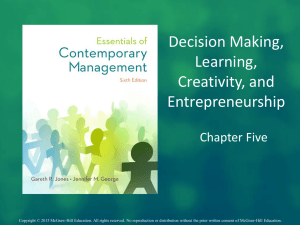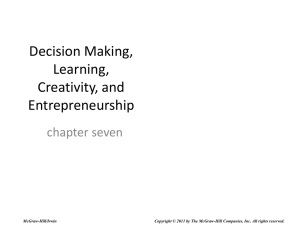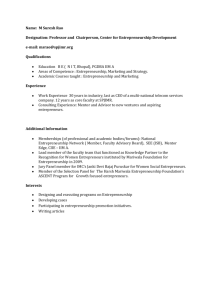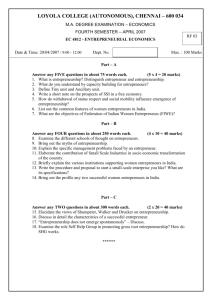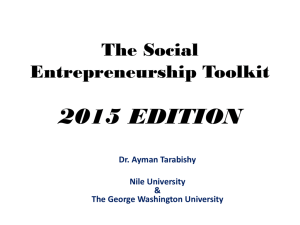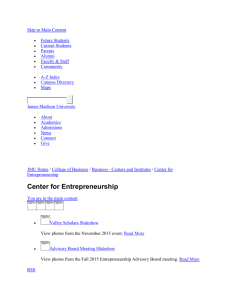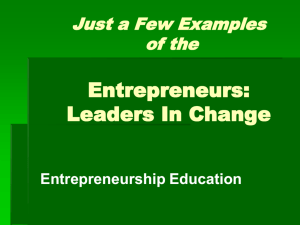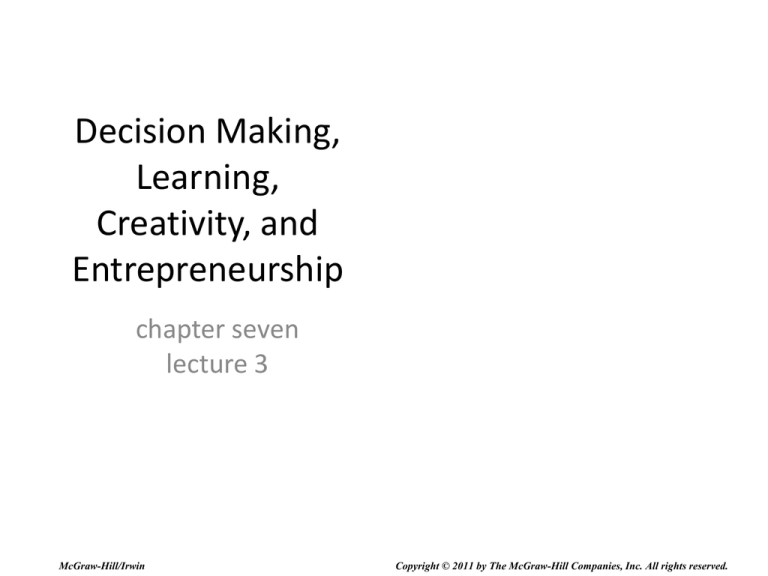
Decision Making,
Learning,
Creativity, and
Entrepreneurship
chapter seven
lecture 3
McGraw-Hill/Irwin
Copyright © 2011 by The McGraw-Hill Companies, Inc. All rights reserved.
Senge’s Principles for Creating a
Learning Organization
Figure 7.8
7-2
Building Group Creativity
• Brainstorming
– Managers meet face-to-face to generate and
debate many alternatives.
• Production Blocking
– Occurs because group members cannot
simultaneously make sense of all the alternatives
being generated, think up additional alternatives,
and remember what they were thinking
7-3
Building Group Creativity
• Nominal Group Technique
– A decision making technique in which group
members write down ideas and solutions, read
their suggestions to the whole group, and discuss
and then rank the alternatives.
• Useful when an issue is controversial and when
different managers might be expected to
champion different courses of action
7-4
Building Group Creativity
• Delphi Technique
– A decision-making technique in which group
members do not meet face-to-face but respond in
writing to questions posed by the group leader.
7-5
Entrepreneurship
• Entrepreneurs
– Individuals who notice opportunities and take the
responsibility for mobilizing the resources
necessary to produce new and improved goods
and services.
• Social entrepreneurs
– those who pursue initiatives and opportunities to
address social problems and needs in order to
improve society
7-6
Entrepreneurship
• Intrapreneurs
– A manager, scientist, or researcher who works
inside an organization and notices opportunities
to develop new or improved products and better
ways to make them.
7-7
Characteristics of Entrepreneurs
• Open to experience: they are original thinkers
and take risks.
• Internal locus of control: they take
responsibility for their own actions.
• High self-esteem: they feel competent and
capable.
• High need for achievement: they set high
goals and enjoy working toward them.
7-8
Entrepreneurship and Management
• Frequently, founding entrepreneur lacks the
skills, patience, and experience to engage in
the difficult and
challenging work
of management
7-9
Intrapreneurship and
Organizational Learning
• Product champions
– taking ownership of a product from concept to
market.
• Skunkworks
– keeping a group of intrapreneurs separate from
the rest of the firm.
• Rewards for innovation
– linking innovation by workers to valued rewards.
7-10
Example – Xerox PARC
• The Palo Alto Research Center is a Xerox
Research & Development division
• Many innovations such as the laser printer,
personal workstation, WYSIWYG printing, and
GUI came out of PARC
7-11
Video Case: Laser Monks
• Which aspect of LaserMonks’ formula—
quality products, competitive prices, or social
entrepreneurship—would increase the chance
that you would buy from this company?
• Which entrepreneurial characteristics does
Brother Bernard McCoy exhibit?
• What does the fact that the monks no longer
handle their company’s operations say about
them as managers?
7-12

